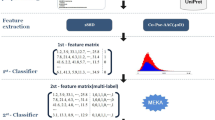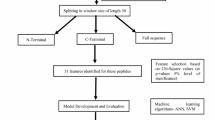Abstract
Climate change combined with the increase of extreme weather phenomena, has significantly influenced marine ecosystems, resulting in water overheating, increase of sea level and rising of the acidity of surface waters. The potential impacts in the biodiversity of sensitive ecosystems (such as Mediterranean sea) are obvious. Many organisms are under extinction, whereas other dangerous invasive species are multiplied and thus they are destroying the ecological equilibrium. This research paper presents the development of a sophisticated, fast and accurate Food Pathogen Detection (FPD) system, which uses the biologically inspired Artificial Intelligence algorithm of Extreme Learning Machines. The aim is the automated identification and control of the extremely dangerous for human health invasive fish species “Lagocephalus Sceleratus”. The matching is achieved through extensive comparisons of protein and DNA sequences, known also as DNA barcodes following an ensemble learning approach.
Access this chapter
Tax calculation will be finalised at checkout
Purchases are for personal use only
Preview
Unable to display preview. Download preview PDF.
Similar content being viewed by others
References
Frank, J.R., Olden, J.D.: Assessing the Effects of Climate Change on Aquatic Invasive Species. Conservation Biology 22(3), 521–533 (2008). doi:10.1111/j.1523-1739.2008.00950.x. Society for Conservation Biology
Kheifets, J., Rozhavsky, B., Solomonovich, Z.G., Rodman, M., Soroksky, A.: Severe Tetrodotoxin Poisoning after Consumption of Lagocephalus sceleratus (Pufferfish, Fugu) Fished in Mediterranean Sea, Treated with Cholinesterase Inhibitor. Case Reports in Critical Care 2012, Article ID 782507, 3 p. (2012). doi:10.1155/2012/782507
Akova, F., Dundar, M., Davisson, V.J., Hirleman, D.E., Bhunia, A.K., Robinson, J.P., Rajwa, B.: A Machine-Learning Approach to Detecting Unknown Bacterial Serovars. Statistical Analysis and Data Mining (2011). doi:10.1002/sam.10085
Pan, W., Zhao, J., Chen, Q.: Classification of foodborne pathogens using near infrared laser scatter imaging system with multivariate calibration (2015). doi:10.1038/srep09524
Rajwa, B., Dundar, M.M., Akova, F., Bettasso, A., Patsekin, V., Hirleman, E.D., Bhunia, A.K., Robinson, J.P.: Discovering the Unknown: Detection of Emerging Pathogens Using a Label-Free Light-Scattering System. Cytometry Part A 77A, 1103–1112 (2010)
Rajwa, B., Venkatapathi, M., Ragheb, K., Banada, P.P., Hirleman, E.D., Lary, T., Robinson, J.P.: Automated classification and recognition of bacterial particles in flow by multi-angle scatter measurement and a support-vector machine classifier. Cytometry A 73(4), 369–379 (2008). doi:10.1002/cyto.a.20515
Pan, Y.: Protein structure prediction and understanding using machine learning methods. In: 2005 IEEE Granular Computing, vol. 1 (2005). doi:10.1109/GRC.2005.1547225
Ma, X., Hu, L.: Extracting sequence features to predict DNA-binding proteins using support vector machine. In: 2013 Fifth International Conference on Computational and Information Sciences (ICCIS) (2013). doi:10.1109/ICCIS.2013.48
Yu, D.-J., Hu, J., Li, Q.M., Tang, Z.M., Yang, J.Y., Shen, H.B.: Constructing Query-Driven Dynamic Machine Learning Model With Application to Protein-Ligand Binding Sites Prediction. NanoBioscience, IEEE, 14(1) (2015)
Leigh, D., Thredgold, E.A.V., Lenehan, C.E.: Direct detection of histamine in fish flesh using microchip electrophoresis with capacitively coupled contactless conductivity detection. Anal. Methods, 1802–1808 (2015). doi:10.1039/C4AY02866J
Lipman, D.J., Pearson, W.R.: Rapid and sensitive protein similarity searches. Science 227(4693), 1435–1441 (1985). doi:10.1126/science.2983426. PMID 2983426
Moraglio, A., Di Chio, C., Poli, R.: Geometric Particle Swarm Optimization 2008, Article ID 143624, 14 p. (2008). doi:10.1155/2008/143624
Rokach, Lior: Ensemble-based classifiers. Artificial Intelligence Review 33(1–2), 1–39 (2010). doi:10.1007/s10462-009-9124-7
Cambria, E., Huang, G.-B.: Extreme Learning Machines. IEEE Intelligent Systems (2013)
Huang, G.-B.: An Insight into Extreme Learning Machines: Random Neurons, Random Features and Kernels (2014). doi:10.1007/s12559-014-9255-2, Springer
Nitesh, V., Chawla, B.K.W., Hall, L.O., Kegelmeyer, W.P.: SMOTE: Synthetic Minority Over-sampling Technique. Journal of Artificial Intelligence Research 16 (2002)
Author information
Authors and Affiliations
Corresponding authors
Editor information
Editors and Affiliations
Rights and permissions
Copyright information
© 2015 Springer International Publishing Switzerland
About this paper
Cite this paper
Demertzis, K., Iliadis, L. (2015). Intelligent Bio-Inspired Detection of Food Borne Pathogen by DNA Barcodes: The Case of Invasive Fish Species Lagocephalus Sceleratus. In: Iliadis, L., Jayne, C. (eds) Engineering Applications of Neural Networks. EANN 2015. Communications in Computer and Information Science, vol 517. Springer, Cham. https://doi.org/10.1007/978-3-319-23983-5_9
Download citation
DOI: https://doi.org/10.1007/978-3-319-23983-5_9
Published:
Publisher Name: Springer, Cham
Print ISBN: 978-3-319-23981-1
Online ISBN: 978-3-319-23983-5
eBook Packages: Computer ScienceComputer Science (R0)




